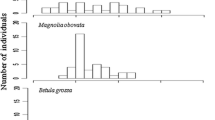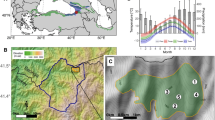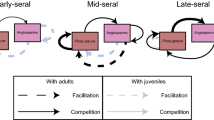Abstract
The dark taiga of Siberia is a boreal vegetation dominated by Picea obovata, Abies sibirica, and Pinus sibirica during the late succession. This paper investigates the population and age structure of 18 stands representing different stages after fire, wind throw, and insect damage. To our knowledge, this is the first time that the forest dynamics of the Siberian dark taiga is described quantitatively in terms of succession, and age after disturbance, stand density, and basal area. The basis for the curve–linear age/diameter relation of trees is being analyzed. (1) After a stand-replacing fire Betula dominates (4,000 trees) for about 70 years. Although tree density of Betula decreases rapidly, basal area (BA) reached >30 m2/ha after 40 years. (2) After fire, Abies, Picea, and Pinus establish at the same time as Betula, but grow slower, continue to gain height and eventually replace Betula. Abies has the highest seedling number (about 1,000 trees/ha) and the highest mortality. Picea establishes with 100–400 trees/ha, it has less mortality, but reached the highest age (>350 years, DBH 51 cm). Picea is the most important indicator for successional age after disturbance. Pinus sibirica is an accompanying species. The widely distributed “mixed boreal forest” is a stage about 120 years after fire reaching a BA of >40 m2/ha. (3) Wind throw and insect damage occur in old conifer stands. Betula does not establish. Abies initially dominates (2,000–6,000 trees/ha), but Picea becomes dominant after 150–200 years since Abies is shorter lived. (4) Without disturbance the forest develops into a pure coniferous canopy (BA 40–50 m2/ha) with a self-regenerating density of 1,000 coniferous canopy trees/ha. There is no collapse of old-growth stands. The dark taiga may serve as an example in which a limited set to tree species may gain dominance under certain disturbance conditions without ever getting monotypic.












Similar content being viewed by others
References
Alexeyev VA, Birdsey RA (1998) Carbon storage in forests and peatlands of Russia. The USDA Forest Service. General Tech Rep NE-244, p 135
Bergeron Y, Dubuc M (1989) Succession in the southern part of the Canadian boreal forest. Vegetatio 79:51–63
Clark DF, Antos JA, Bradfield GE (2003) Succession in sub-boreal forests of west-central British Columbia. J Veg Sci 14(5):721–732
Day RJ (1972) Stand structure, succession, and use of Southern Albertas Rocky Mountain Forest. Ecology 53(3):472–478
De Grandpre L, Morissette J, Gauthier S (2000) Long-term post-fire changes in the northeastern boreal forest of Quebec. J Veg Sci 11(6):791–800
Doetterl M (2000) Strukturen, Muster und Sukzession der Tannen-/Fichtentaiga in Sibirien. Diplom Thesis, University of Bayreuth, Bayreuth, p 119
Dyrenkow SA (1984) Structura I dinamika tajeschnych jelnikov. Nauka, Leningrad
Ellenberg H (1978) Vegetation Mitteleuropas mit den Alpen in ökologischer Sicht. Verlag Euren Ulmer, Stuttgart, p 981
Etzrod N (2002) Anwendungsmöglichkeiten von SAR-Interferometrie und optischer Fernerkundungsdaten für die Kartierung zentralsibirischer Primärwälder zur Abschätzung von Stoff-Flüssen und –Bilanzen. Dr Thesis, Universität Göttingen, Germany
Fox JF (1977) Alternation and coexistence of tree species. Am Midland Nat 111:69–89
Frelich LE, Reich PB (1995) Spatial patterns and succession in a Minnesota Southern-Boreal Forest. Ecol Monogr 65(3):325–346
Furyaev VV, Wein RW, MacLean DA (1983) Fire influences in Abies-dominated forests. In: Wein RW, MacLean DA (eds) The role of fire in northern circumpolar ecosystems, 18th edn. Wiley, Chichester, pp 221–232
Galipeau C, Kneeshaw D, Bergeron Y (1997) White spruce and balsam fir colonisation of a site in the southeastern boreal forest as observed 68 years after fire. Can J Forest Res 27(2):139–147
Green DF, Zasada JC, Sirois L, Kneeshaw D, Morin H, Charron I, Simard MJ (1999) A review of the regeneration dynamics of North American boreal forest tree species. Can J Forest Res 29:824–839
Gutsell SL, Johnson EA (2002) Accurately ageing trees and examining their height-growth rates: implications for interpreting forest dynamics. J Ecol 90(1):153–166
Hilfstafeln für die Forstwirtschaft (1990) Zusammenstellung für den Gebrauch in der Bayerischen Staatsforstverwaltung. Bayer. Staatsministerium für Ernährung, Landwirtschaft und Forsten. München, p 334
Hughes JW, Bechtel DA (1997) Effect of distance from forest edge on regeneration of red spruce and balsam fir in clearcuts. Can J Forest Res 27(12):2088–2096
Ivanov VI (ed) (1990) Atlas Krasnayarskovo Kraya i Respubliki Chakatii. Novosibirskaya kartograficheskaya fabrika Raskartographii. Novosibirsk, p 82 (in Russian)
Johnson EA, Miyanishi K (2001) Forest fires—behaviour and ecological effects. Academic, San Diego
Kneeshaw DD, Bergeron Y (1996) Ecological factors affecting the abundance of advance regeneration in Quebec’s southwestern boreal forest. Can J Forest Res 26(5):888–898
Kneeshaw DD, Burton DJ (1997) Canopy and age structures of some old sub-boreal Picea stands in British Columbia. J Veg Sci 8(5):615–626
Kobe RK, Coates KD (1997) Models of sapling mortality as a function of growth to characterize interspecific variation in shade tolerance of eight tree species of northwestern British Columbia. Can J Forest Res 27(2):227–236
Kramer H (1988) Waldwachstumslehre. Verlag Paul Parey, Hamburg 374
Levins R, Culver D (1971) Regional coexistence of species and competition between rare species. In: Proceedings of the National Academy of Sciences of the United States of America 68:1246–1248
Mollicone D (2002) A new remote sensing based methodology to determine fire frequency and forest succession in the boreal forest. PhD Thesis, University of Padova
Mollicone D, Achard F, Marchesini LB, Federici S, Laipold M, Roselini S, Schulze ED, Valentini R (2002) A new remote sensing based approach to determine forest fire cycle: case study of the central Siberia Abies dominated taiga. Tellus 54B:688–695
Nakagawa M, Kurahashi A, Hogetsu T (2003) The regeneration characteristics of Picea jezoensis and Abies sacchalinensis on cut stumps in the sub-boreal forests of Hokkaido Tokyo University Forest. Forest Ecol Manag 180:353–359
Niklasson M (2002) A comparison of three age determination methods for suppressed Norway spruce: implications for age structure analysis. Forest Ecol Manag 161(1–3):279–288
Oosting HJ, Reed JF (1952) Virgin Spruce-Fir of the Medicin Bow Mountains, Wyoming. Ecol Monogr 22(2):69–91
Pacala S, Rees M (1998) Models suggesting field experiments to test two hypotheses explaining successional diversity. Am Nat 152(5):729–737
Pauley EF, Nodvin SC, Nicholas NS, Rose AK, Coffey TB (1996) Vegetation, biomass, and nitrogen pools in a spruce-fir forest of the Great Smoky Mountains National Park. Bull Torrey Bot Club 123(4):318–329
Röser C, Montagnani L, Schulze ED, Mollicone D, Kolle O, Meroni M, Papale D, Marchesini B, Federici S, Valentini R (2002) Net CO2 exchange rates in three successional stages of the “Dark Taiga” of central Siberia. Tellus 54B:642–654
Schukov AB (1969) Lessa Krasnojarskowo Kraja. Moskow, Nauka, p 70
Schulze E-D, Lloyd J, Kelliher FM, Wirth C, Rebmann C, Lühker B, Mund M, Knohl A, Milyokova I, Schulze W, Ziegler W, Varlagin A, Sogachov A, Valentini R, Dore S, Grigoriev S, Kolle O, Tchebakova N, Vygodskaya N (1999) Productivity of forests in the Eurosiberian boreal region and their potential to act as a carbon sink—a synthesis. Global Change Biol 5:703–722
Schulze ED, Vygodskaya NN, Tschebakova N, Czimczik CI, Kozlov D, Lloyd J, Mollicone D, Parfenova E, Sidorov K, Varlagin A, Wirth Ch (2002) The Eurasian transect: an introduction to the experimental design. Tellus 54B:421–428
Simard MJ, Bergeron Y, Sirois L (1998) Conifer seedling recruitment in a southeastern Canadian boreal forest: the importance of substrate. J Veg Sci 9(4):575–582
Swidenko AZ, Nilsson S (1994) What do we know about the Siberian forest. Ambio 23:396–404
Usoltsev VA (2001) Forest biomass of northern Eurasia: database and geography. Russian Academy of Sciences, Ural Branch. Yekarinenburg, p 706
Usoltsev VA (2003) Forest biomass of northern Eurasia: limits of productivity and their geography. Russian Academy of Sciences, Ural Branch Yekarinenburg, p 402
Varga P, Klinka K (2001) Structure of high-elevation, old-growth stands in west-central British Columbia. Can J Forest Res 31(12):2098–2106
Veblen TT (1986) Treefalls and the coexistence of conifers in subalpine forest of the central Rockies. Ecology 67(3):644–649
Viereck LA (1973) Wildfire in the Taiga of Alaska. Quater Res 3:465–495
Walter H (1974) Die Vegetation Osteuropas, Nord- und Zentralasiens. Gustav Fischer Verlag, Stuttgart, p 452
Wirth C (2004) Fire regime and tree diversity in boreal and high elevation forests: implications for biogeochemical cycles. In: Scherer-Lorenzen M, Körner Ch, Schulze E-D (eds) The ecological significance of forest diversity Ecological Studies, vol 176. Springer New York, Berlin, Heidelberg, pp 309–346
Acknowledgements
We greatly acknowledge the help of Martina Doetterl, Carola Roeser and Norbert Etzrodt in the field, which was in part extremely hard and difficult. We thank Inge Schulze for her generous help to maintain our health, and a great number of Russian, Italian, and German co-workers that helped with the inventory work.This study was funded by the Max-Planck Institute of Biogeochemistry, the EU Projects Eurosiberian Carbonflux (ENV-CT97-0491) and Terrestrial Carbon Observation Systems (EVK2-CT-2001-00131 TCOS Siberia).
Author information
Authors and Affiliations
Corresponding author
Additional information
Communicated by Christian Koerner
Rights and permissions
About this article
Cite this article
Schulze, ED., Wirth, C., Mollicone, D. et al. Succession after stand replacing disturbances by fire, wind throw, and insects in the dark Taiga of Central Siberia. Oecologia 146, 77–88 (2005). https://doi.org/10.1007/s00442-005-0173-6
Received:
Accepted:
Published:
Issue Date:
DOI: https://doi.org/10.1007/s00442-005-0173-6




